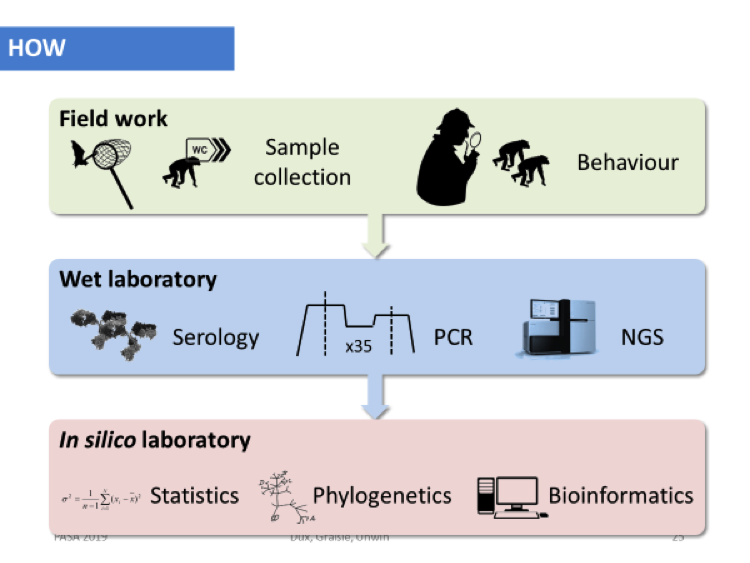Methods
Summary
We will mainly sample 22 individuals of Group Nidai totally habituated to human presence by collecting their faeces. Collected samples are preserved in different buffer (70% Ethanol, RNA later, formalin and liquid nitrogen) as well as in bacterial transport media (STGG). These samples are used to detect a wide range of pathogens (parasites, bacteria, and viruses), but also for genetic and dietary studies. From the literature and in our own experience, most outbreaks and infectious disease-related mortality in great apes results from the exposure to a limited number of pathogens. Depending on the symptoms or gross pathological investigation, we will therefore initially screen for the presence of DNA/RNA from select pathogens: human respiratory syncytial virus, human metapneumovirus, coronaviruses, Pasteurella multocida, Streptococcus pneumoniae (all involved in respiratory outbreaks), monkeypox, Treponema pallidum (involved in skin disease outbreaks) and ebolavirus and Bacillus anthracis. These pathogens are known to spillover either way with humans.

Laboratory Analysis

Pre Analysis Plan
Sample collection and Analysis
1) Fecal samples are collected in the Moukalaba-Doudou National Park (MDNP, 2°29.9'S,10°21'E), Gabon from gorilla in different habituation stages. We will collect samples from group Nidai (a fully habituated group of 10 gorillas), group Musiru which is in the early stages of habituation and the group Mbara, an unhabituated group whose home range overlaps with a village bordering the MDNP. The faecal samples will be collected at the nest site of the different groups, as often as these are encountered. One sample from each nest will be collected in order to attempt to avoid repeated sampling of the same individual. The following data are collected at the time of sampling: name of the collector, sampling date, site (MDNP), gorilla group, sample age (<24h or >24h), maximum width of the faeces (mm), consistency, abnormal content, collection time, collection location, GPS coordinates, tube name, tube preservative and any other remarks (consistent with Annexes 20-22 of the RHMW). Concerning the collection site the following data will be collected: height, vegetation type, tree species (when arboreal), light gap, topography. In addition faeces samples are collected routinely from all individuals with a sampling density of one sample per individual per month. Samples are collected using single use gloves and plastic bags from known individuals of great apes as soon as the individual reached a distance of 7 meters to the faeces deposited (due to hygiene rules), the time between defecation and collection is noted. At Doussala Research Station the samples preserved in RNA later as well as bacterial transport media (STGG), or samples will also be preserved frozen when liquid nitrogen available.
2) Mosquitoes sampling will be carried out in five sites across the Park. Adult females will be collected using CDC light traps between 5pm and 7am for five consecutive night monthly. The geographical coordinates for each sampling site will be recorded using a hand-held GPS receiver. Collected specimens will be taxonomically identified according to standard morphological features (Gillies & Coetze, 1987) at Doussala Research Station. Then, they will be individually stored in 1.5 mL tubes at -20°C and sent to IRET Libreville for molecular análisis
3) Sampling of hematophagous flies will be carried out for one year following a gradient of human activity from primary forest to villages. The Flies will be collected by using Nzi traps and Vavoua. In the park, we will place 20 traps (10 Nzi and10 Vavoua) for 2 weeks and each trap will be activated from 7 am to 5 pm. Freshly collected hematophagous flies will be identified using a stereo-microscope and taxonomic procedure. The fly species will be determined following the determination keys. The engorged flies will be dissected individually in a drop of Dulbecco phosphate buffered saline (1X DPBS). Each blood meal will be transferred in a 1.5 ml microtube containing 50 ml of RNAlater stabilization solution to stabilize and protect the nucleic acids of vertebrate hosts and blood meal pathogens. Samples will be stored at room temperature during field sessions and frozen at -80°C until screened for pathogens.
Protocols
This project has not yet shared any protocols.